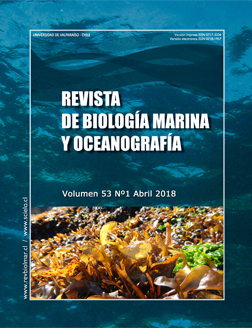Seasonal and diel variation in the distribution of dominant zooplankton in a tropical coastal lagoon
DOI:
https://doi.org/10.4067/S0718-19572018000100039Keywords:
Zooplankton, Canonical correspondence, ANOVA, Intermittent, VeracruzAbstract
The dominant zooplankton of the La Mancha lagoon, Veracruz, Mexico, was analyzed with the objective of evaluating its seasonal and diel variability, as well as the influence of the main environmental variables on this variability. From May 2012 to April 2013, every month a 24-h cycle was completed, taking samples every 4 h, at the mouth of the lagoon. Simultaneously with zooplankton sampling, in situ environmental parameters such as temperature, dissolved oxygen, salinity, chlorophyll a and number of phytoplankton cells were recorded. We collected 54 taxa (mainly holoplankton) and 10 of them were considered dominant (total abundance > 0.5%). The zooplankton community was dominated mainly by two species of copepods (Acartia tonsa and Pseudodiaptomus pelagicus), as well as zoea larvae of brachyura (~85%). At seasonal level, the total abundance of zooplankton showed significant pulses throughout the year, one in February-March dominated by copepods and another in September-October, dominated by decapod larvae. On a diel scale, although total zooplankton abundance was significantly higher at night, only P. pelagicus, amphipods, megalopae, and other decapod larvae showed significant differences at this level. According to a Canonical Correspondence Analysis, the mouth stage (open/close), the number of cyanophytes and precipitation were the most important environmental factors in determining the abundance of the dominant zooplankton.
Downloads
Downloads
Published
How to Cite
Issue
Section
License
• Los autores que publican en la RBMO transfieren sus derechos de publicación a la Universidad de Valparaíso, conservando los derechos de propiedad intelectual para difundir ampliamente el artículo y la revista en cualquier formato.
• La RBMO autoriza el uso de figuras, tablas y extractos breves de su colección de manuscritos, en trabajos científicos y educacionales, siempre que se incluya la fuente de información.





